1932 Rolls-Royce 20/25HP Park Ward Saloon - barnfind project
Discussion
Hello all,
Now that the children are back at school (hooray!), I have a moment to update the 20/25 thread. Some progress has been made over the summer, but not all of it good! So, for this update, I shall work with the title “Engine woes….”
In the July update, I’d got to a point where the car was a rolling chassis again, with most parts having been assessed and a list made of the missing/damaged/seized (delete as appropriate) parts. I’d identified that the engine had an earlier 20HP cylinder head fitted, which I needed to remove. Firstly I wanted to collate all the 20HP parts in one place, secondly so that I could make a better assessment of the condition of the 20/25 engine, which would in turn inform the budgeting and costing part of the restoration.
Having cleaned and soaked each fitting, the cylinder head nuts came off easily enough. As per many other parts on the car, I am finding lots of little indications of the life the car has led, plus the tinkering of previous owners. So here I found some less than perfect nuts, as well as a washer or two missing. I soaked the engine studs with penetrating oil, but I could not get the head to shift, even with some gentle blows with a rubber mallet. Stuck for the moment, and not wishing to damage what appears to be a lovely intact (and rather rare) 20HP cast iron head, I turned my attention back to the cylinder bores.

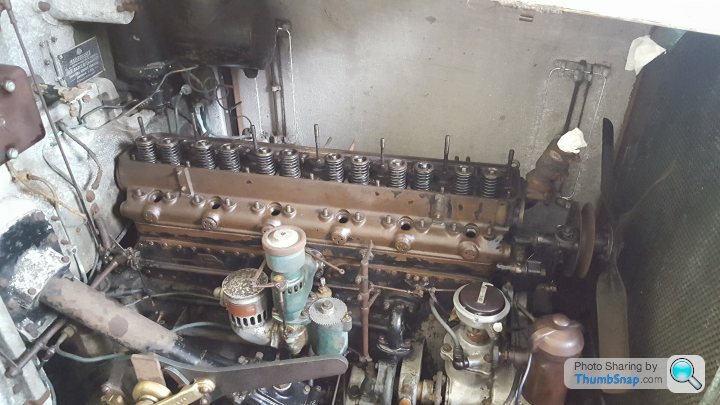
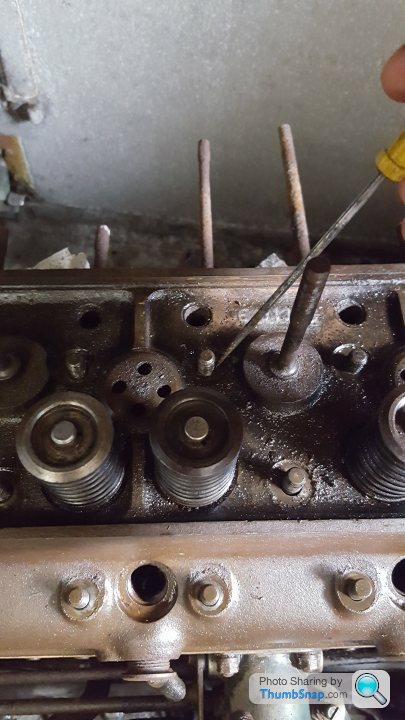
I had managed to clean up each of the cylinders to some degree but they remained pretty mucky and I was concerned that I had not done anything to unstick the piston rings. Having read around the subject a bit, opinions seemed to vary about the best fluids to use – my own preference in the end was diesel, being both light enough to penetrate even the smallest gaps and coming with a lubricating element too. So I dutifully filled each cylinder with diesel via the plug hole, gave each a gentle stir and allowed it to do its job.
After a week or so, it seemed that no. 1 and no. 6 cylinders seemed to be dropping in level – this was encouraging, I thought, as perhaps the diesel was making its was down through the piston rings and into the sump – the first glimmer of hope for getting the rings unstuck. I added some more diesel and excitedly began to daydream about the possibility of getting the engine turn over. Since the “clean & lubricate” method had worked on every other item on the chassis and powertrain so far (even the clutch now engages and disengages), could I complete the set? Strangely, on adding diesel this time, I could have sworn that I heard a gently trickling noise – maybe this was just diesel making its way down into the sump via the piston rings. On checking the LH side of the engine, it was clear that diesel was weeping out from the headgasket joint and running down the side of the block. Again encouraged that this was all helping to free things up, I set about wiping up the LH side of the block, including the tappet chest covers.
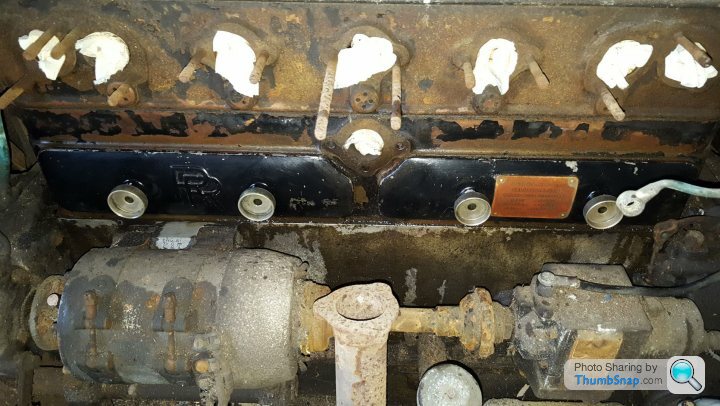
These covers, with their beautiful RR embossing in the cast aluminium, cover the location in the side of block where the camshaft (single side camshaft on this engine) followers feed up to push on the bottom of the pushrods. The adjustment of the valve clearances is made by small adjustments to the pushrod lengths, all accessed via these neat tappet chest covers in the side of the block. While cleaning these covers, I was tempted to remove them and clean what I could of the inside of the tappet chest and assess the condition of the ends of the cam followers.
I cleaned back the first part of the rear tappet chest opening when disaster struck – my fingers touched upon a rough edge. On inspection, I thought I could see a line in the oily muck caked onto the block. More cleaning followed and it was like my world falling apart around me… the lines were the start of a huge spiders web of cracks in the material of the side of the cylinder block. I hurriedly cleaned the front chest, which too revealed a huge “burst” in the side of the block. I simply sat down on the floor of the garage and shook my head. The project had gone from “difficult” to “off the scale difficult”. For the first time, I began to doubt whether it could be completed.
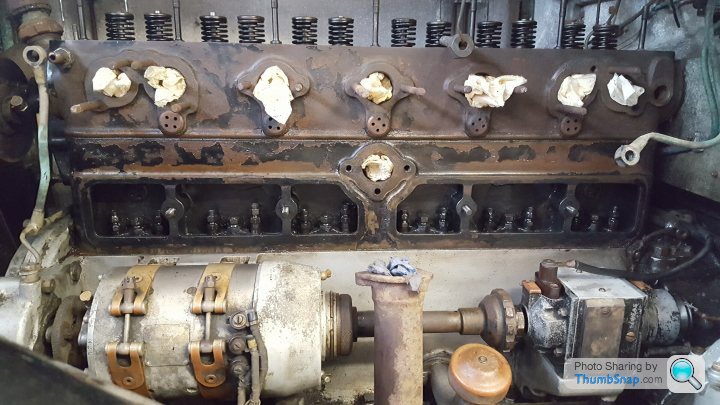
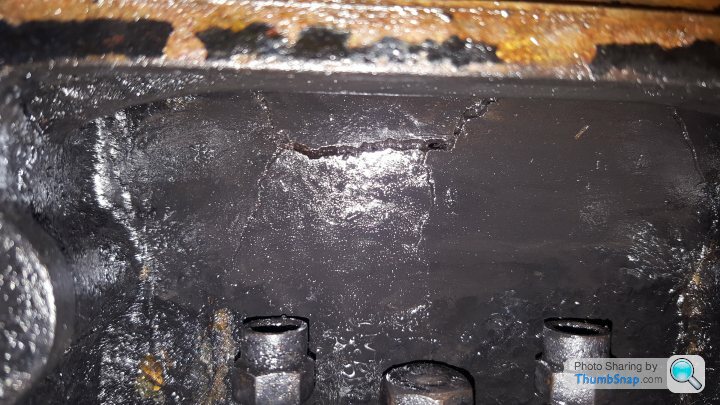
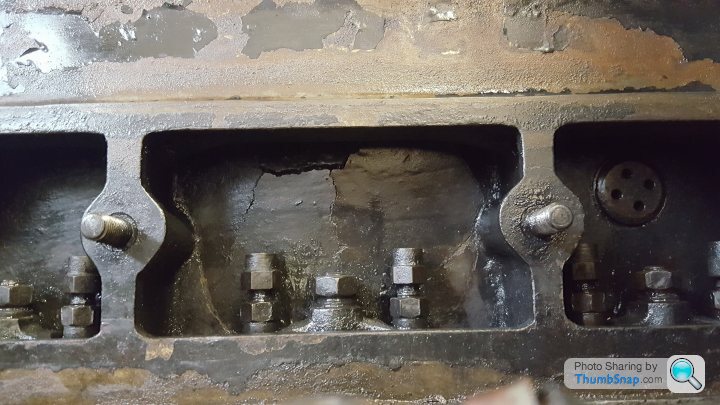
A replacement cylinder head on a 20/25 is one thing – I had budgeted for such a thing in my plans when I bought the car. So many of them have new heads that it is almost a given. But a wrecked block is another order of magnitude of a problem. Given that the car already has oversized pistons (+45 thou), a new block would probably mean new (original dimension) pistons too. I could see the £ signs spiralling upwards. So I did the only thing possible – I had another cup of tea.
I decided that I needed to get to the bottom of the implications of what I had found. If I did need a new engine, I needed to understand a) if it was possible to get the parts required and b) how much would it cost. I contacted the 2 main companies in the UK who are capable of supplying what I needed, Ristes and Fiennes. I worked out a specification of what I thought I needed, with fingers crossed that I could keep and reuse as much of the original engine as possible. The key item that I wanted to reuse was the crankcase, thus being able to preserve the original engine number, which is stamped into the casting just above the dynamo.
The ”new” engine would need to be as follows:
• New head, including valves (assume that rocker cover, rocker shaft and rockers were reused)
• New block, fitted with new original dimension pistons (to the 5.25:1 compression ratio spec, as per original), new little and big end bearings for original con rods.
• Cleaned, crack detected and reground crankshaft, with new main bearings.
• Cleaned and inspected crankcase, including oilways
• Reconditioned torsional damper (on front of the engine), new rollers, pins and springs on cam followers, cleaned and reused camshaft, new bushes/bearings for timing gears
• New clutch
• Dynamic balancing of rotating crankshaft/clutch assembly
• Assemble all the above with new seals and gaskets (as needed) and clean/refit sump and front timing casing.
Once I had the above engine in place, I would then be able to complete the engine build by “dressing” it with all the ancillary components (dynamo, magneto, distributor, carburettor etc) which I would restore myself. The spec above would give a “sealed” engine assembly too – thus preventing ingress of dirt etc.
When contacting Fiennes, I was lucky enough to be helped with my enquiry by Will Fiennes, who founded the company in 1976. His knowledge and experience are well known in Rolls-Royce and Bentley circles and it was a pleasure to work with him. The final quote was detailed and covered everything we had discussed. While it is a lot of money (the block alone costs £6033.50 +VAT), if I consider that the rebuild of the car as a whole would be over a ~10 year period, the engine cost when spread over that timeframe, is little more than I spent on keeping my XJS in fine fettle on an annual basis….
The engine will be the most expensive item in the restoration plan and, with that key piece of information in place, I was now able to plan out the overall timing and sequencing of what I could do and when. It all felt a little better than when I had discovered the cracked block, but the project would now be very much for the long haul!
I hope you enjoyed the update, take care.
AF
Now that the children are back at school (hooray!), I have a moment to update the 20/25 thread. Some progress has been made over the summer, but not all of it good! So, for this update, I shall work with the title “Engine woes….”
In the July update, I’d got to a point where the car was a rolling chassis again, with most parts having been assessed and a list made of the missing/damaged/seized (delete as appropriate) parts. I’d identified that the engine had an earlier 20HP cylinder head fitted, which I needed to remove. Firstly I wanted to collate all the 20HP parts in one place, secondly so that I could make a better assessment of the condition of the 20/25 engine, which would in turn inform the budgeting and costing part of the restoration.
Having cleaned and soaked each fitting, the cylinder head nuts came off easily enough. As per many other parts on the car, I am finding lots of little indications of the life the car has led, plus the tinkering of previous owners. So here I found some less than perfect nuts, as well as a washer or two missing. I soaked the engine studs with penetrating oil, but I could not get the head to shift, even with some gentle blows with a rubber mallet. Stuck for the moment, and not wishing to damage what appears to be a lovely intact (and rather rare) 20HP cast iron head, I turned my attention back to the cylinder bores.



I had managed to clean up each of the cylinders to some degree but they remained pretty mucky and I was concerned that I had not done anything to unstick the piston rings. Having read around the subject a bit, opinions seemed to vary about the best fluids to use – my own preference in the end was diesel, being both light enough to penetrate even the smallest gaps and coming with a lubricating element too. So I dutifully filled each cylinder with diesel via the plug hole, gave each a gentle stir and allowed it to do its job.
After a week or so, it seemed that no. 1 and no. 6 cylinders seemed to be dropping in level – this was encouraging, I thought, as perhaps the diesel was making its was down through the piston rings and into the sump – the first glimmer of hope for getting the rings unstuck. I added some more diesel and excitedly began to daydream about the possibility of getting the engine turn over. Since the “clean & lubricate” method had worked on every other item on the chassis and powertrain so far (even the clutch now engages and disengages), could I complete the set? Strangely, on adding diesel this time, I could have sworn that I heard a gently trickling noise – maybe this was just diesel making its way down into the sump via the piston rings. On checking the LH side of the engine, it was clear that diesel was weeping out from the headgasket joint and running down the side of the block. Again encouraged that this was all helping to free things up, I set about wiping up the LH side of the block, including the tappet chest covers.

These covers, with their beautiful RR embossing in the cast aluminium, cover the location in the side of block where the camshaft (single side camshaft on this engine) followers feed up to push on the bottom of the pushrods. The adjustment of the valve clearances is made by small adjustments to the pushrod lengths, all accessed via these neat tappet chest covers in the side of the block. While cleaning these covers, I was tempted to remove them and clean what I could of the inside of the tappet chest and assess the condition of the ends of the cam followers.
I cleaned back the first part of the rear tappet chest opening when disaster struck – my fingers touched upon a rough edge. On inspection, I thought I could see a line in the oily muck caked onto the block. More cleaning followed and it was like my world falling apart around me… the lines were the start of a huge spiders web of cracks in the material of the side of the cylinder block. I hurriedly cleaned the front chest, which too revealed a huge “burst” in the side of the block. I simply sat down on the floor of the garage and shook my head. The project had gone from “difficult” to “off the scale difficult”. For the first time, I began to doubt whether it could be completed.



A replacement cylinder head on a 20/25 is one thing – I had budgeted for such a thing in my plans when I bought the car. So many of them have new heads that it is almost a given. But a wrecked block is another order of magnitude of a problem. Given that the car already has oversized pistons (+45 thou), a new block would probably mean new (original dimension) pistons too. I could see the £ signs spiralling upwards. So I did the only thing possible – I had another cup of tea.
I decided that I needed to get to the bottom of the implications of what I had found. If I did need a new engine, I needed to understand a) if it was possible to get the parts required and b) how much would it cost. I contacted the 2 main companies in the UK who are capable of supplying what I needed, Ristes and Fiennes. I worked out a specification of what I thought I needed, with fingers crossed that I could keep and reuse as much of the original engine as possible. The key item that I wanted to reuse was the crankcase, thus being able to preserve the original engine number, which is stamped into the casting just above the dynamo.
The ”new” engine would need to be as follows:
• New head, including valves (assume that rocker cover, rocker shaft and rockers were reused)
• New block, fitted with new original dimension pistons (to the 5.25:1 compression ratio spec, as per original), new little and big end bearings for original con rods.
• Cleaned, crack detected and reground crankshaft, with new main bearings.
• Cleaned and inspected crankcase, including oilways
• Reconditioned torsional damper (on front of the engine), new rollers, pins and springs on cam followers, cleaned and reused camshaft, new bushes/bearings for timing gears
• New clutch
• Dynamic balancing of rotating crankshaft/clutch assembly
• Assemble all the above with new seals and gaskets (as needed) and clean/refit sump and front timing casing.
Once I had the above engine in place, I would then be able to complete the engine build by “dressing” it with all the ancillary components (dynamo, magneto, distributor, carburettor etc) which I would restore myself. The spec above would give a “sealed” engine assembly too – thus preventing ingress of dirt etc.
When contacting Fiennes, I was lucky enough to be helped with my enquiry by Will Fiennes, who founded the company in 1976. His knowledge and experience are well known in Rolls-Royce and Bentley circles and it was a pleasure to work with him. The final quote was detailed and covered everything we had discussed. While it is a lot of money (the block alone costs £6033.50 +VAT), if I consider that the rebuild of the car as a whole would be over a ~10 year period, the engine cost when spread over that timeframe, is little more than I spent on keeping my XJS in fine fettle on an annual basis….
The engine will be the most expensive item in the restoration plan and, with that key piece of information in place, I was now able to plan out the overall timing and sequencing of what I could do and when. It all felt a little better than when I had discovered the cracked block, but the project would now be very much for the long haul!
I hope you enjoyed the update, take care.
AF
Always good to have an update on this thread, glad you're still getting dug into it!
Don't be overly disheartened by the crack in the block just yet, it may well be fixable, and likewise with the bores, if they're not salvageable for any further overboring, perhaps sleeving them is a possibility?
If you're looking at over £7k for a fresh block otherwise, I think it's worth getting it all apart and contacting some specialists for a realistic assessment of what can be done. The actual basic machining work involved isn't ridiculously expensive.
Couple of things:
Diesel in the engine, yes, I like this technique also, though my approach is to not only go through the spark plug holes and fill the cylinders, but to pour it in through the oil filler and absolutely fill the engine to the brim, so it's also soaking the piston/bore interface from underneath.
Penetrating oil, I've started using the American product PB Blaster, and I find it to be very good. Also for dealing with seized stuff, I bought myself a cheap induction heater, and it's great for getting bolts etc good and hot without waving a torch around and heating everything in the firing line.
Cylinder heads, maybe not directly helpful to you right now, but a technique which can be helpful if the engine can be turned over with a bar is to ensure you're on a compression stroke so the valves are closed (not an issue if your valvetrain is dismantled), and with the piston down the bore, feed nylon rope jnto the cylinder through the spark plug hole to fill up the cylinder(s). Then turn the engine to bring the piston up and it'll push on the underside of the head.
Won't necessarily get a stuck one off, but it helps add direct vertical pressure upwards while you tap away with your choice of lead/copper/rubber mallet.
Don't be overly disheartened by the crack in the block just yet, it may well be fixable, and likewise with the bores, if they're not salvageable for any further overboring, perhaps sleeving them is a possibility?
If you're looking at over £7k for a fresh block otherwise, I think it's worth getting it all apart and contacting some specialists for a realistic assessment of what can be done. The actual basic machining work involved isn't ridiculously expensive.
Couple of things:
Diesel in the engine, yes, I like this technique also, though my approach is to not only go through the spark plug holes and fill the cylinders, but to pour it in through the oil filler and absolutely fill the engine to the brim, so it's also soaking the piston/bore interface from underneath.
Penetrating oil, I've started using the American product PB Blaster, and I find it to be very good. Also for dealing with seized stuff, I bought myself a cheap induction heater, and it's great for getting bolts etc good and hot without waving a torch around and heating everything in the firing line.
Cylinder heads, maybe not directly helpful to you right now, but a technique which can be helpful if the engine can be turned over with a bar is to ensure you're on a compression stroke so the valves are closed (not an issue if your valvetrain is dismantled), and with the piston down the bore, feed nylon rope jnto the cylinder through the spark plug hole to fill up the cylinder(s). Then turn the engine to bring the piston up and it'll push on the underside of the head.
Won't necessarily get a stuck one off, but it helps add direct vertical pressure upwards while you tap away with your choice of lead/copper/rubber mallet.
I’ll go a bit left field here...
As the block is now scrap, could it be reverse engineered and cast, then machined- on a practical basis?
I was at the 3D printing show 5 (?) years ago, and a stand there had an old Voisin car on it. The engine block had failed on the car, a well know weak point apparently, and there were no blocks left. The owner put his big pants on and decided to have the block recast/machined.
It was scanned in, reverse engineered into CAD, the patterns were 3D printed and he had 20 blocks cast, and 5 machined. He sold them immediately – much to his surprise.
One suspects the financial commitment required may be beyond one's pockets for this case though.
Unless other owners need spare engine blocks?
As the block is now scrap, could it be reverse engineered and cast, then machined- on a practical basis?
I was at the 3D printing show 5 (?) years ago, and a stand there had an old Voisin car on it. The engine block had failed on the car, a well know weak point apparently, and there were no blocks left. The owner put his big pants on and decided to have the block recast/machined.
It was scanned in, reverse engineered into CAD, the patterns were 3D printed and he had 20 blocks cast, and 5 machined. He sold them immediately – much to his surprise.
One suspects the financial commitment required may be beyond one's pockets for this case though.
Unless other owners need spare engine blocks?
Thank you all for the supportive comments - they really do help!
@ classicaholic - yes, man maths is a very powerful thing! However, the geek in me means I keep a detailed spreadsheet of costs for all my cars, so I know what I've spent and when.... somehow, the number at the bottom of the page always seems much bigger than I think it should be... No idea why! But I don't yet have such a spreadsheet running for GBT47. Perhaps this is a good thing!
@ InitialDave - PB blaster does get a good write up, doesn't it? I will try some and I like the ideas of a top and bottom soak of diesel to help loosen things off, as well as the nylon rope inside the cylinder on the compression stroke to help with shifting a stuck head.
@bucksmanuk - I like the 3D printing idea. In fact I have explored this with the fittings I need to complete doors etc (missing door handles, window winders, door latches) - as these are all Park Ward specific, some reverse engineering of the originals will be needed. Alistair at A2P2 Specialist Reverse Engineering has been extremely helpful with sourcing potential parts to copy and coming up with quotes and lead times for scanning and CAD of new parts. As you perhaps know, it is one thing to scan a part, it is very different to then engineer and develop it into a proper functioning part. Many firms offer the scanning capability, but not all can do the engineering side. Fortunately that is my old life coming back to me, so this should be fine. Specifically for the engine issue on GBT47, I don't think I will need to do this for the block. The small horsepower Rolls-Royces are very well supported by the specialists and almost all parts for the original Rolls-Royce supplied chassis (powertrain, chassis etc) can still be procured, at a price. The Voisin example you quote (and I love the design ethos of Voisin - in my mind an interesting alternative to the mainstream, a little like Bugatti) does not surprise me - I doff my cap to the owner that went to those lengths to get their car running again. I hope my challenges come in slightly smaller than that!
@ R56Cooper - LS3 lump? That would certainly be interesting! In much the same vein as friend who suggested putting the internals from a Nissan Leaf into it.... I think I'll try to stick with the original method for now!
Take care.
AF
@ classicaholic - yes, man maths is a very powerful thing! However, the geek in me means I keep a detailed spreadsheet of costs for all my cars, so I know what I've spent and when.... somehow, the number at the bottom of the page always seems much bigger than I think it should be... No idea why! But I don't yet have such a spreadsheet running for GBT47. Perhaps this is a good thing!
@ InitialDave - PB blaster does get a good write up, doesn't it? I will try some and I like the ideas of a top and bottom soak of diesel to help loosen things off, as well as the nylon rope inside the cylinder on the compression stroke to help with shifting a stuck head.
@bucksmanuk - I like the 3D printing idea. In fact I have explored this with the fittings I need to complete doors etc (missing door handles, window winders, door latches) - as these are all Park Ward specific, some reverse engineering of the originals will be needed. Alistair at A2P2 Specialist Reverse Engineering has been extremely helpful with sourcing potential parts to copy and coming up with quotes and lead times for scanning and CAD of new parts. As you perhaps know, it is one thing to scan a part, it is very different to then engineer and develop it into a proper functioning part. Many firms offer the scanning capability, but not all can do the engineering side. Fortunately that is my old life coming back to me, so this should be fine. Specifically for the engine issue on GBT47, I don't think I will need to do this for the block. The small horsepower Rolls-Royces are very well supported by the specialists and almost all parts for the original Rolls-Royce supplied chassis (powertrain, chassis etc) can still be procured, at a price. The Voisin example you quote (and I love the design ethos of Voisin - in my mind an interesting alternative to the mainstream, a little like Bugatti) does not surprise me - I doff my cap to the owner that went to those lengths to get their car running again. I hope my challenges come in slightly smaller than that!
@ R56Cooper - LS3 lump? That would certainly be interesting! In much the same vein as friend who suggested putting the internals from a Nissan Leaf into it.... I think I'll try to stick with the original method for now!
Take care.
AF
I think this is more what was in mind when LS3 was mentioned:
https://www.corvsport.com/chevrolet-ls3-engine/
Sorry, don't know how to embed the picture into the thread on this forum.
https://www.corvsport.com/chevrolet-ls3-engine/
Sorry, don't know how to embed the picture into the thread on this forum.
Hello all,
It has been a bit quiet on the restoration front for the last month or so, as a number of small parallel parts of the project have been underway. But I have now some more progress to share! This update is called – Key, V5C and original registration number...
When you buy a “normal” car in the UK, some things are expected at every transaction. You would expect, on receipt of your hard-earned money, to receive the car, its keys and the new owner's part of the V5C registration document, which in time would produce the full V5C registration document in your name. In short, you would have a “proper” car – one which you could insure, tax, MOT (if needed). When I bought GBT47, quite a number of these things were missing – so much so, that the DVLA did not have any record of the car! So, aside from the physical restoration, a significant amount of work has gone into getting keys, V5C and the car’s registration number sorted.
The key was the first element to be resolved. On a 20/25 you do not need a key necessarily to start the car. The main switchpack, located to the right of the steering wheel, contains to the master switches for the car – one for side, tail and head lamps, the other for ignition and charge. To start, you would simply move the ignition thumb switch to the desired position, set the hand controls (maybe turning on the starting carburettor – more on this when we get to the fuel system!) and press the foot operated starter switch. The key, from a security perspective, simply locks the overall switch pack mechanism, so once it is turned, neither the ignition nor the light master switch will move. Fortunately for me, GBT47 had been delivered “unlocked” – with the switch pack free to move. On the downside, there was no sign of the key!

From a study of the original chassis cards, it was clear that the key profile was recorded when the car was built. If, and it was a big if, no one had changed the locks in the last 90 years, it would in theory be possible to get the key recut to this original key profile. The ever helpful team at the Rolls-Royce Enthusiasts Club run a service where, for a fee, they will get a new key cut for you to the original chassis specification.
As an aside, the wealth of information collated by Rolls-Royce owners and enthusiasts over the years never ceases to amaze me. For this key project, the “definitive” work on Rolls-Royce keys was complete by Gil Fuqua in the USA and published in “The Flying Lady” March / April 2000. If you need any more information about keys for your Rolls-Royce, track down a copy of this article!
After a short wait for the key to be delivered, I was able to find out if my gamble had paid off – was the ignition key barrel original and would the new key work? I dosed with lock with plenty of WD40 and tentatively inserted the new key. I gave it a gentle tweak and it began to turn…. And fully rotated, locking the switchpack, on the 2nd attempt. A few more cycles and it was working perfectly.
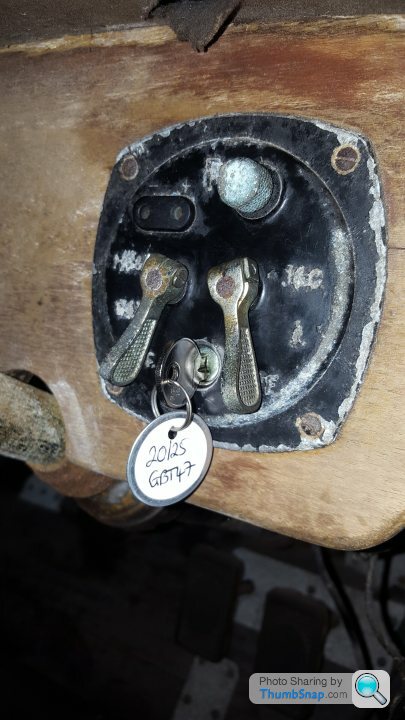
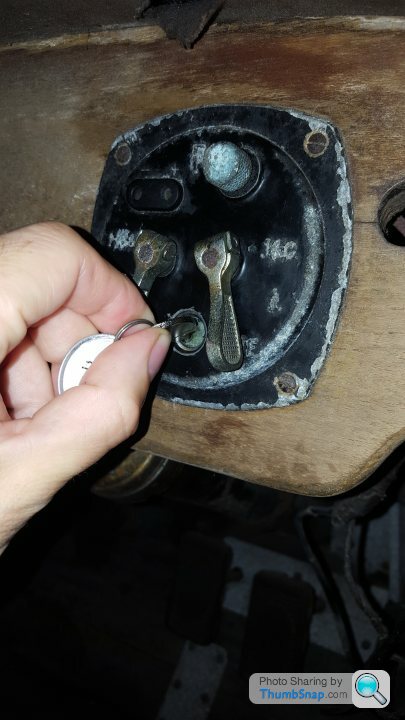
Feeling flushed with success, I moved on to the only exterior door lock on the car, fitted to the nearside passenger door. Again, dose with lots of WD40, clean it all up a bit and then try the key – same result, the key worked perfectly. I was very pleased that GBT47 had a car key again – another step closer to actually working.

To complete the key part of the story, I wanted to have something special as the key ring for the car. During the cleaning process, I have uncovered a number of small clues and signs from the car’s previous owners. 2 such items have been a 1943 George VI three pence coin (found in the bottom of the rear right door case) and a 1957 silver Elizabeth II six pence (underneath the rear left ashtray in the C post). Both small coins must have been lost by the car’s previous owners (or companions), so they provide a lovely direct link to the car’s past. I cleaned both coins up, using lemon juice and metal polish, drilled some holes and popped them on a spare key ring. I hope you all approve!
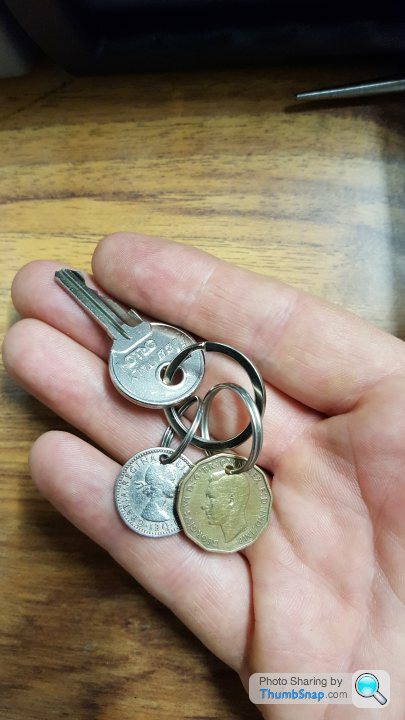

If the key was relatively simple task, the challenge of obtaining a V5C for the car and retaining the car’s original registration number (GX 8868) was far harder. It all hinged around the fact that the car had been off the road since 1963 and had never been included in the various updates to the DVLA database over the years. As far as the DVLA were concerned, the car did not exist. Secondly, though I had images of the original buff continuation logbook – covering the period 1945 to 1963, I didn’t have the physical document to hand.
The DVLA have a scheme whereby you can apply to register your car, if it has been off the road since the digitalisation of records in the early 1980’s, which is supported by the many owners clubs in the UK. The bar set by the DVLA is high, when it comes to the evidence that they require to grant a new V5C and register a car under its original registration mark. Through my previous posts on GBT47, I have given a glimpse of the documentation that I have put together on the car and it felt pretty compelling that I could prove that the car was what I said it was. I bundled up the evidence, made my application, but the DVLA were not able to issue a V5C. That said, the case worker who looked at the mountain of information that I had sent was very supportive and suggested a repeat application with some changes – if only I could track down some certified evidence which linked the chassis number to the registration number, in period!
Several months passed, with regular discussions with Abbie, the Archivist at the Rolls-Royce Enthusiasts Club. Through her efforts, she contacted the respected Rolls-Royce historian Bernard King, who was able to identify where he and Tom Clarke had been able to verify GBT47’s chassis and registration number for their book – “The Rolls-Royce 20/25H.P.” – which is the definitive list of chassis numbers and build information for the model.
Buried deep in the archives at the RREC was a sales ledger, dating from 1952, from “Paddon Brothers Ltd” – a respected dealer in Rolls-Royce and Bentley motor cars in both the pre and post war eras. The sale ledger identified that GBT47 had been sold in December 1952 via Paddons to the car’s third owner J.M.F May AND critically, it showed the car’s chassis number (GBT47) alongside the car’s registration number (GX 8868). Eureka! Here was primary evidence that could be certified as being authentic by the RREC and would satisfy the DVLA. A second application was posted off to DVLA and in late October I received an envelope containing the new V5C, confirming that the original registration number had been retained.
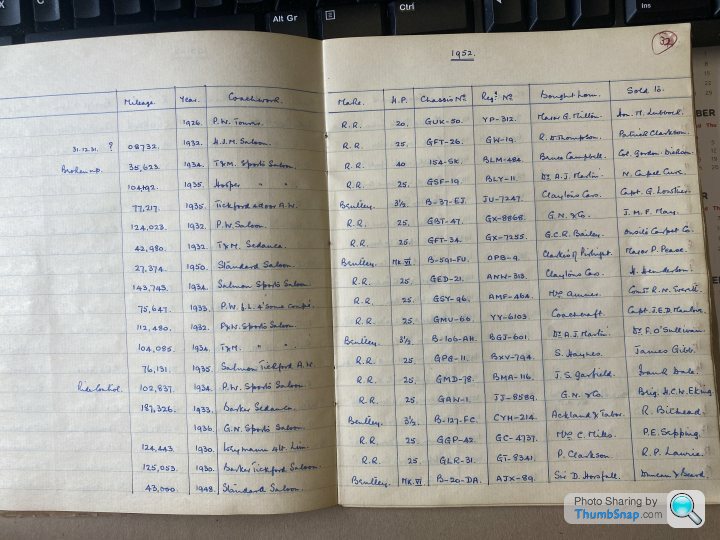
So now GBT47 is a step closer to being a proper car – with a key, a V5C document and the original registration number. One final little gem came to light during the V5C research – if you look carefully on the 1952 sales ledger, it shows that the car’s mileage is 124,023… so the current mileage of 75,432 is more likely to be 175,432! The odometer only has 5 digits, so there will always be some uncertainty. In some ways I hope that the 175k mileage is correct – it would equate to around 5,500 miles per year, including during the war, for the 31 years that the car was on the road. It has certainly been well used by the 9 previous owners!
Take care,
AF
It has been a bit quiet on the restoration front for the last month or so, as a number of small parallel parts of the project have been underway. But I have now some more progress to share! This update is called – Key, V5C and original registration number...
When you buy a “normal” car in the UK, some things are expected at every transaction. You would expect, on receipt of your hard-earned money, to receive the car, its keys and the new owner's part of the V5C registration document, which in time would produce the full V5C registration document in your name. In short, you would have a “proper” car – one which you could insure, tax, MOT (if needed). When I bought GBT47, quite a number of these things were missing – so much so, that the DVLA did not have any record of the car! So, aside from the physical restoration, a significant amount of work has gone into getting keys, V5C and the car’s registration number sorted.
The key was the first element to be resolved. On a 20/25 you do not need a key necessarily to start the car. The main switchpack, located to the right of the steering wheel, contains to the master switches for the car – one for side, tail and head lamps, the other for ignition and charge. To start, you would simply move the ignition thumb switch to the desired position, set the hand controls (maybe turning on the starting carburettor – more on this when we get to the fuel system!) and press the foot operated starter switch. The key, from a security perspective, simply locks the overall switch pack mechanism, so once it is turned, neither the ignition nor the light master switch will move. Fortunately for me, GBT47 had been delivered “unlocked” – with the switch pack free to move. On the downside, there was no sign of the key!

From a study of the original chassis cards, it was clear that the key profile was recorded when the car was built. If, and it was a big if, no one had changed the locks in the last 90 years, it would in theory be possible to get the key recut to this original key profile. The ever helpful team at the Rolls-Royce Enthusiasts Club run a service where, for a fee, they will get a new key cut for you to the original chassis specification.
As an aside, the wealth of information collated by Rolls-Royce owners and enthusiasts over the years never ceases to amaze me. For this key project, the “definitive” work on Rolls-Royce keys was complete by Gil Fuqua in the USA and published in “The Flying Lady” March / April 2000. If you need any more information about keys for your Rolls-Royce, track down a copy of this article!
After a short wait for the key to be delivered, I was able to find out if my gamble had paid off – was the ignition key barrel original and would the new key work? I dosed with lock with plenty of WD40 and tentatively inserted the new key. I gave it a gentle tweak and it began to turn…. And fully rotated, locking the switchpack, on the 2nd attempt. A few more cycles and it was working perfectly.


Feeling flushed with success, I moved on to the only exterior door lock on the car, fitted to the nearside passenger door. Again, dose with lots of WD40, clean it all up a bit and then try the key – same result, the key worked perfectly. I was very pleased that GBT47 had a car key again – another step closer to actually working.

To complete the key part of the story, I wanted to have something special as the key ring for the car. During the cleaning process, I have uncovered a number of small clues and signs from the car’s previous owners. 2 such items have been a 1943 George VI three pence coin (found in the bottom of the rear right door case) and a 1957 silver Elizabeth II six pence (underneath the rear left ashtray in the C post). Both small coins must have been lost by the car’s previous owners (or companions), so they provide a lovely direct link to the car’s past. I cleaned both coins up, using lemon juice and metal polish, drilled some holes and popped them on a spare key ring. I hope you all approve!


If the key was relatively simple task, the challenge of obtaining a V5C for the car and retaining the car’s original registration number (GX 8868) was far harder. It all hinged around the fact that the car had been off the road since 1963 and had never been included in the various updates to the DVLA database over the years. As far as the DVLA were concerned, the car did not exist. Secondly, though I had images of the original buff continuation logbook – covering the period 1945 to 1963, I didn’t have the physical document to hand.
The DVLA have a scheme whereby you can apply to register your car, if it has been off the road since the digitalisation of records in the early 1980’s, which is supported by the many owners clubs in the UK. The bar set by the DVLA is high, when it comes to the evidence that they require to grant a new V5C and register a car under its original registration mark. Through my previous posts on GBT47, I have given a glimpse of the documentation that I have put together on the car and it felt pretty compelling that I could prove that the car was what I said it was. I bundled up the evidence, made my application, but the DVLA were not able to issue a V5C. That said, the case worker who looked at the mountain of information that I had sent was very supportive and suggested a repeat application with some changes – if only I could track down some certified evidence which linked the chassis number to the registration number, in period!
Several months passed, with regular discussions with Abbie, the Archivist at the Rolls-Royce Enthusiasts Club. Through her efforts, she contacted the respected Rolls-Royce historian Bernard King, who was able to identify where he and Tom Clarke had been able to verify GBT47’s chassis and registration number for their book – “The Rolls-Royce 20/25H.P.” – which is the definitive list of chassis numbers and build information for the model.
Buried deep in the archives at the RREC was a sales ledger, dating from 1952, from “Paddon Brothers Ltd” – a respected dealer in Rolls-Royce and Bentley motor cars in both the pre and post war eras. The sale ledger identified that GBT47 had been sold in December 1952 via Paddons to the car’s third owner J.M.F May AND critically, it showed the car’s chassis number (GBT47) alongside the car’s registration number (GX 8868). Eureka! Here was primary evidence that could be certified as being authentic by the RREC and would satisfy the DVLA. A second application was posted off to DVLA and in late October I received an envelope containing the new V5C, confirming that the original registration number had been retained.

So now GBT47 is a step closer to being a proper car – with a key, a V5C document and the original registration number. One final little gem came to light during the V5C research – if you look carefully on the 1952 sales ledger, it shows that the car’s mileage is 124,023… so the current mileage of 75,432 is more likely to be 175,432! The odometer only has 5 digits, so there will always be some uncertainty. In some ways I hope that the 175k mileage is correct – it would equate to around 5,500 miles per year, including during the war, for the 31 years that the car was on the road. It has certainly been well used by the 9 previous owners!
Take care,
AF
What a wonderful read this is! your experience with the DVLA is not dissimilar to mine when - opposite end of the size scale! - I repatriated an Austin Seven AD tourer (1928) from Seattle. It went to the USA in the late 70's and was NEVER titled in it's 40 odd years in the USA . My first job was to get it titled (by a friend to whom I sent the car in San Francisco) so I could "export" it!.
The car had all it's ex UK export & shipping documents (including freight by train across the USA!) and part of an old log book. My first attempt was to try and tax the car before it left the US as it showed up on the DVLA records, but they weren't having that as there appeared to be a discrepancy with the Reg. No. - This meant I had to pay Import duty and VAT.at the UK port.
When the car arrived I set about registering it. The discrepancy was two digits in the number had been transposed, but everything else matched! DVLA were really helpful and the case officer actually retrieved the original microfiche from when the records were computerised and agreed that they had made the error and reinstated the correct original number! I was so pleased that I didn't think to try and get back the Duty & VAT!
The car had all it's ex UK export & shipping documents (including freight by train across the USA!) and part of an old log book. My first attempt was to try and tax the car before it left the US as it showed up on the DVLA records, but they weren't having that as there appeared to be a discrepancy with the Reg. No. - This meant I had to pay Import duty and VAT.at the UK port.
When the car arrived I set about registering it. The discrepancy was two digits in the number had been transposed, but everything else matched! DVLA were really helpful and the case officer actually retrieved the original microfiche from when the records were computerised and agreed that they had made the error and reinstated the correct original number! I was so pleased that I didn't think to try and get back the Duty & VAT!
Gassing Station | Readers' Cars | Top of Page | What's New | My Stuff





